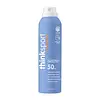What's inside
What's inside
 Key Ingredients
Key Ingredients

 Benefits
Benefits

 Concerns
Concerns

 Ingredients Side-by-side
Ingredients Side-by-side

Titanium Dioxide 3.4%
Cosmetic ColorantZinc Oxide 15.7%
Cosmetic ColorantWater
Skin ConditioningButyloctyl Salicylate
Skin ConditioningDicaprylyl Carbonate
EmollientIsononyl Isononanoate
EmollientPropanediol
SolventIsocetyl Stearoyl Stearate
EmollientMethyl Dihydroabietate
Cetearyl Alcohol
EmollientAloe Barbadensis Leaf Juice
Skin ConditioningMusa Sapientum Fruit Extract
Skin ConditioningBentonite
AbsorbentGlycerin
HumectantTocopherol
AntioxidantCitric Acid
BufferingAlumina
AbrasiveSodium Gluconate
Skin ConditioningBisabolol
MaskingCaprylhydroxamic Acid
Cellulose Gum
Emulsion StabilisingCaprylyl Glycol
EmollientCoco-Glucoside
CleansingMicrocrystalline Cellulose
AbsorbentPolyhydroxystearic Acid
EmulsifyingPolyester-8
Skin ConditioningSilica
AbrasiveSodium Stearoyl Glutamate
CleansingC18-21 Alkane
SolventTitanium Dioxide 3.4%, Zinc Oxide 15.7%, Water, Butyloctyl Salicylate, Dicaprylyl Carbonate, Isononyl Isononanoate, Propanediol, Isocetyl Stearoyl Stearate, Methyl Dihydroabietate, Cetearyl Alcohol, Aloe Barbadensis Leaf Juice, Musa Sapientum Fruit Extract, Bentonite, Glycerin, Tocopherol, Citric Acid, Alumina, Sodium Gluconate, Bisabolol, Caprylhydroxamic Acid, Cellulose Gum, Caprylyl Glycol, Coco-Glucoside, Microcrystalline Cellulose, Polyhydroxystearic Acid, Polyester-8, Silica, Sodium Stearoyl Glutamate, C18-21 Alkane
 Reviews
Reviews

Ingredients Explained
These ingredients are found in both products.
Ingredients higher up in an ingredient list are typically present in a larger amount.
Dicaprylyl Carbonate comes from carbonic acid and caprylyl alcohol, a fatty alcohol. It is an emollient and gives skin a velvet feel. The sources of Dicaprylyl Carbonate may be synthetic or from animals.
As an emollient, Dicaprylyl Carbonate creates a film on the skin. This film traps moisture in, keeping your skin soft and hydrated.
Tocopherol (also known as Vitamin E) is a common antioxidant used to help protect the skin from free-radicals and strengthen the skin barrier. It's also fat soluble - this means our skin is great at absorbing it.
Vitamin E also helps keep your natural skin lipids healthy. Your lipid skin barrier naturally consists of lipids, ceramides, and fatty acids. Vitamin E offers extra protection for your skin’s lipid barrier, keeping your skin healthy and nourished.
Another benefit is a bit of UV protection. Vitamin E helps reduce the damage caused by UVB rays. (It should not replace your sunscreen). Combining it with Vitamin C can decrease sunburned cells and hyperpigmentation after UV exposure.
You might have noticed Vitamin E + C often paired together. This is because it is great at stabilizing Vitamin C. Using the two together helps increase the effectiveness of both ingredients.
There are often claims that Vitamin E can reduce/prevent scarring, but these claims haven't been confirmed by scientific research.
Learn more about Tocopherol